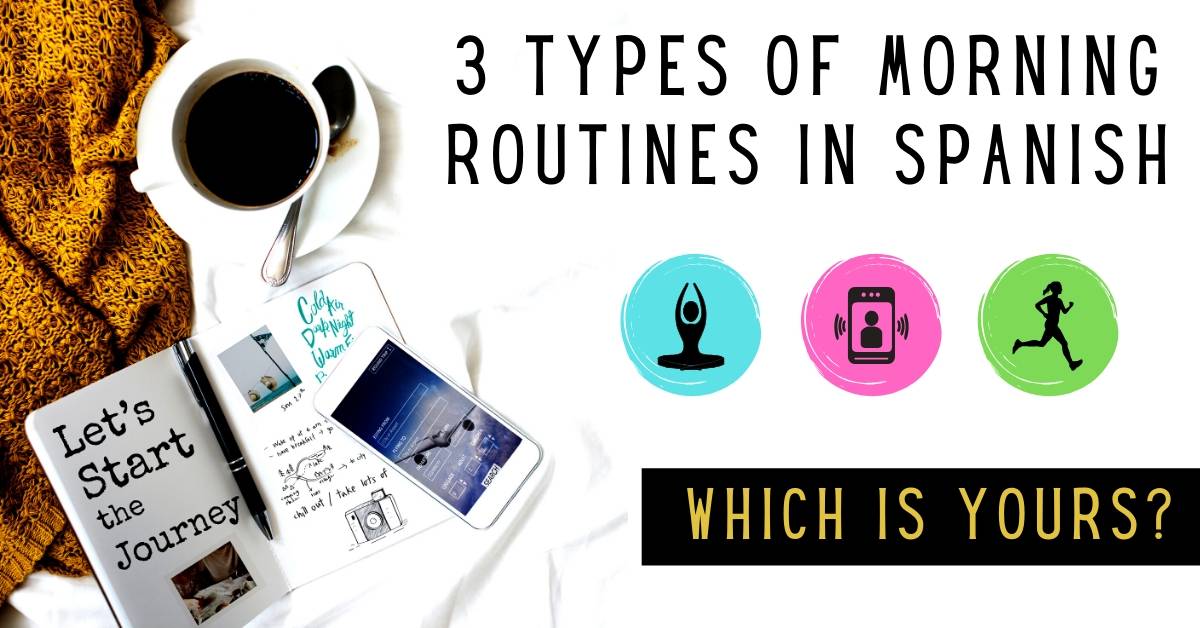
3 Types of Morning Routines in Spanish: Which Is Yours?
Are you a morning person? Or do you require time, effort, and/or coffee to fully wake up each day?
The way we start our day sets the tone for the whole day. Creating space in your morning for both joy and achievement is a fabulous way to cultivate balance and structure in your daily life.
This post explores the concept of routines in Spanish—and provides some thought-provoking tips on how you can develop or enhance your own morning routine!
Routines in Spanish: Basic Vocabulary
Before we dive into the three types, let’s gather some words and phrases related to routines in Spanish.
| Spanish | English |
| despertar | to wake someone up |
| despertarse | to wake up (oneself) |
| levantarse | to get up |
| hacer la cama | to make the bed |
| vestirse | to get dressed |
| prepararse | to get ready |
| ducharse | to shower |
| bañarse | to bathe |
| lavarse | to wash |
| cepillarse los dientes | to brush your teeth |
| lavarse el pelo / la cabeza | to wash your hair |
| secarse el pelo | to dry your hair |
| cepillarse el pelo | to brush your hair |
| peinarse | to comb your hair |
| afeitarse | to shave |
| maquillarse / pintarse | to put on makeup |
| desayunar / tomar el desayuno | to have breakfast |
| hacer la comida | to cook lunch, to get lunch ready |
| dar de comer al gato / perro | to feed the cat / dog |
| ir al colegio / al trabajo / a la universidad / a la oficina | to go to school / work / university / the office |
| empezar a trabajar / entrar a trabajar | to start work |
| poner el despertador | to set the alarm clock |
| tomarse un descanso / echarse una siesta | to take a rest |

A Note on Reflexive Verbs
Many of the verbs on this list are reflexive. We use a reflexive verb to express that the subject in a sentence performs an action on itself. For example, in Spanish, you don’t bath, tú te bañas (you bathe yourself).
Me lavo el pelo.
I wash my hair.
Te lavas el pelo.
You wash your hair.
Se lava el pelo
S/he washes her/his hair.
Nos lavamos el pelo.
We wash our hair.
Se lavan el pelo.
They wash their hair.
Routines in Spanish: Phrases
¿A qué hora te levantas?
What time do you get up?
¿Con qué frecuencia haces ejercicio? / ¿Cada cuánto haces ejercicio?
How often do you go exercise?
Hago ejercicio una vez / dos veces a la semana / al mes / al año.
I exercise once / twice a week / month / year.
¿Cuánto tardas en llegar al trabajo?
How long does it take you to get to work?
¿Cuánto café bebes?
How much coffee do you drink?
¿Qué sueles desayunar?
What do you usually have for breakfast?
¿Cómo llegas al colegio?
How do you get to school?
¿A qué hora te acuestas?
What time do you go to bed?
¿Cuál es tu rutina matutina?
What is your morning routine?
3 Types of Morning Routines: Which is Yours?
1. The Rush (La Prisa)
When the alarm goes off, you hit snooze a couple of times. Your cama is cozy and warm, and you’d prefer to stay in it. When you finally wake up, your first thought is ¡Estoy tarde!, possibly combined with an expletive.
You rush through the morning. Rushing to get dressed and groomed, rushing to eat a quick and not-necessarily-healthy breakfast, rushing to gather your things, to leave the house and get to work or school on time. Haciendo todo con prisa. It’s a very estresante way to start any day.
2. Stillness (Quietud)
Te despiertas a bit earlier in this scenario. You take advantage of the extra time to work on becoming a better person. Aprovechas the silence to practice a few moments of meditation or prayer. You spend a few moments doing creative visualization and imagining yourself having a wonderful day ahead. You perhaps do some physical ejercicio and work up a sweat. Then you take a shower, read a book, and do a bit of journaling, writing in the stream of consciousness style until you’ve completed three pages, following the morning pages concept from The Artist’s Way.
The early morning is a splendid time for exploración espiritual and/or reading. This type of morning routine is excellent for those who are new to personal development and want to take time to develop a spiritual practice.
3. Productivity (Productividad)
The final category of morning routine involves focusing on work, whether it is paid or unpaid, for your job or for a personal project. If you’re like me, your mind is sharpest in the morning hours. That’s why, when you procrastinas and leave important tasks to the afternoon or the fin del día, they are more likely to be pushed back to the next day (over and over).
Instead, making it a habit to work on quehaceres esenciales each morning is a surefire way to progress. Think about what your goals are and how you could chip away at them a little bit every morning.
- If you’re looking for work, you could submit proposals or applications every morning for half an hour.
- If you want to move to a new country, you could do 25 minutes of foreign language study with Duolingo or Memrise.
- If you want to learn Spanish, you could take an online class with Homeschool Spanish Academy.
- If you’re trying to get back into reading, you could read a chapter or a certain number of pages.
- If you’re a musician, you could practice your instrument.
- If you’re a writer, you could work on a few pages of your book manuscript.
- If you’re an artist, you could do some sketching, painting, or sculpting in the morning.
Figure out what you want to achieve and cuánto tiempo tienes. When you get up, set a timer and get to work on, whether for 5, 25, or 45 minutes! Assigning a set number of minutes per task tends to make it feel less overwhelming.
Strategies for Success
Take a moment to think about what you do in the morning. How do you feel about your morning routine? Check out these helpful tips for improving your daily routines and creating a healthy, happy, natural lifestyle.
- Plan your rutina de la mañana in advance: think about it and write your plan down so you can refer back to it.
- Try to dormirse at a regular time as often as possible and get enough hours of quality sleep.
- Put your celular in another room to keep distractions out of reach when you should be sleeping (it also forces you to get up to turn your alarm off).
- Quit being connected online 24/7. Be connected during certain hours of the day. Devote a set period of time to email, social networking, writing, reading (whatever categories fit your habits) and do no more.
- Make your bed and air your bedroom out in the morning.
- Quit wearing maquillaje. Cosmetics are expensive, time-consuming, unnatural, and unnecessary.
- Quit shopping excessively. Simplify. Declutter. Refuse to wear uncomfortable shoes. Give away all the clothes you haven’t worn in a year.
- Watch less TV. Read more. Watch movies and series online, occasionally.
- Quit drinking so much coffee. Quita fast food, sodas, and sugary juices from your diet.
- Eat less dairy. Coma menos carne.
- Eat fresh foods. Shop at farmers’ markets. Eat local. Eat mindfully.
- Exercise without joining a gym. Get more fresh air.
- Walk more, drive less.
- Be active, energetic, playful. Do yoga. Play sports.
I hope this article inspires you to cultivate a happy, healthy, productive morning routine in your daily life. ¡Viva la vida!
Which is your morning routine and do you wish it were any different? Let us know in the comments!
Explore some more free and fun Spanish resources!
- Keep Your Spanish Skills Sharp Over Summer Vacation
- Master All the Forms of Ser in Spanish: Your Ultimate Grammar Guide
- All You Need to Know About Spanish as a Second Language
- Discover the Joy of Learning Spanish with Summer Fun Activities
- Are Bilingual Children More Likely to Experience a Speech or Language Delay?
- What Is An Umbrella School?
- The Best Homeschool Spanish Curriculum at HSA
- Ride the Wave: Why Bilingualism in English and Spanish Is Your Ticket to Success
- Master All the Forms of Ser in Spanish: Your Ultimate Grammar Guide - July 18, 2024
- 10 Innovative Contemporary Latin American Artists Who Broke the Mold - February 16, 2023
- The Sweetest Guide to Valentine’s Day Vocabulary in Spanish - February 14, 2023





